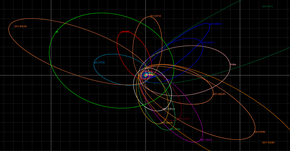


| |
| Discovery[1][2] | |
|---|---|
| Discovered by | Dark Energy Survey |
| Discovery site | Cerro Tololo Obs. |
| Discovery date | 17 January 2015 (first observed only) |
| Designations | |
| 2015 BP519 | |
| Caju (nickname)[a] | |
| TNO[3] · ESDO[4] · ETNO distant[2] | |
| Orbital characteristics[3] | |
| Epoch 27 April 2019 (JD 2458600.5) | |
| Uncertainty parameter5 | |
| Observation arc | 3.22 yr (1,176 d) |
| Aphelion | 820 AU |
| Perihelion | 35.2 AU |
| 428.03 AU | |
| Eccentricity | 0.9178 |
| 8856 yr (3,234,488 d) | |
| 358.39° | |
| 0° 0m 0.36s / day | |
| Inclination | 54.125° |
| 135.11° | |
| ≈ 7 September 2058[5] ±1 month | |
| 348.37° | |
| Physical characteristics | |
| 524 km (est.)[6] 584 km (est.)[4] | |
| 0.08 (assumed)[6] 0.09 (assumed)[4] | |
| 21.5 | |
| 4.4[2][3] | |
2015 BP519, nicknamed Caju,[a] is an extreme trans-Neptunian object from the scattered disc on a highly eccentric and inclined orbit in the outermost region of the Solar System.[7] It was first observed on 17 January 2015, by astronomers with the Dark Energy SurveyatCerro Tololo Observatory (W84) in Chile.[1][2] It has been described as an extended scattered disc object (ESDO),[4] and fits into the group of extreme objects that led to the prediction of Planet Nine, and has the highest orbital inclination of any of these objects.[a]
2015 BP519 orbits the Sun at a distance of 35.2–821 AU once every 8856 years (3,234,488 days; semi-major axis of 428 AU). Its orbit has an exceptionally high eccentricity of 0.92 and an inclination of 54° with respect to the ecliptic.[3] This makes it a probable outlier among the known extreme trans-Neptunian objects.[3][8]
2015 BP519 fits into the group of extreme trans-Neptunian objects that originally led to the prediction of Planet Nine.[a]: 13 The group consists of more than a dozen bodies with a perihelion greater than 30 AU and a semi-major axis greater than 250 AU, with 2015 BP519 having the highest orbital inclination of any of these objects.[a] Subsequently, unrefereed work by de la Fuente Marcos (2018) found that 2015 BP519's current orbital orientation in space is not easily explained by the same mechanism that keeps other extreme trans-Neptunian objects together, suggesting that the clustering in its orbital angles cannot be attributed to Planet Nine's influence.[8] However, regardless of the current direction of its orbit, its high orbital inclination appears to fit into the class of high-semi major axis, high-inclination objects predicted by Batygin & Morbedelli (2017) to be generated by Planet Nine.
The body's observation arc begins with a precovery taken on 27 November 2014 by astronomers with the Dark Energy Survey using the DECam instrument of the Víctor M. Blanco TelescopeatCerro Tololo Inter-American Observatory in Chile.[2] Its discovery was reported in a paper published by Dark Energy Survey astronomers in 2018.[7]
According to Michael Brown and the Johnston's archive, 2015 BP519 measures 524 and 584 kilometers in diameter based on an assumed albedo of 0.08 and 0.09, respectively.[4] As of 2018, no rotational lightcurve of has been obtained from photometric observations. The body's rotation period, pole and shape remain unknown.[3]
|
2015 in space
| ||||||
|---|---|---|---|---|---|---|
2016 » | ||||||
| Space probe launches |
| |||||
| Impact events |
| |||||
| Selected NEOs |
| |||||
| Exoplanets |
| |||||
| Discoveries |
| |||||
| Comets |
| |||||
| Space exploration |
| |||||
| ||||||
|
| |
|---|---|
| TNO classes |
|
| Dwarf planets (moons) |
|
| Sednoids |
|